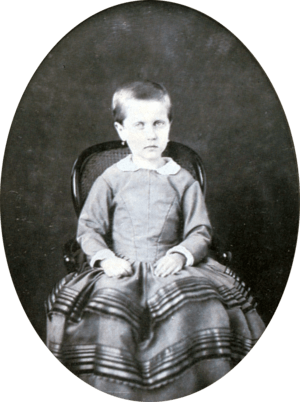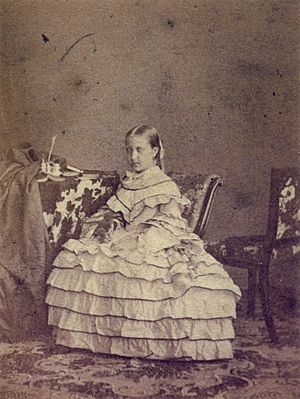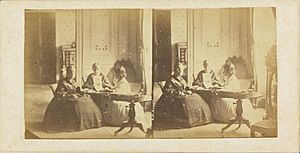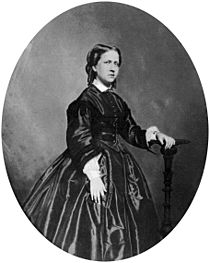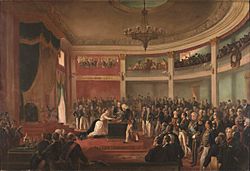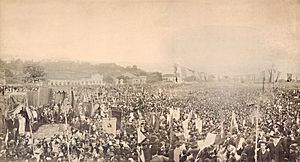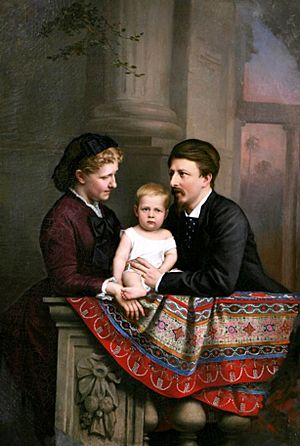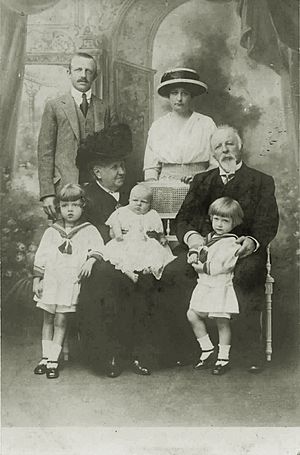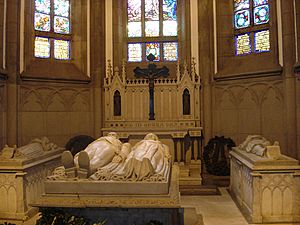Isabel, Princess Imperial of Brazil facts for kids
Quick facts for kids Isabel |
|||||
|---|---|---|---|---|---|
| Princess Imperial of Brazil Countess of Eu |
|||||
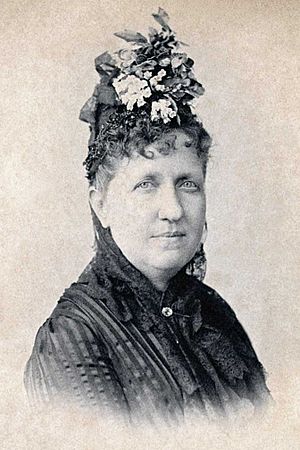
Princess Isabel around age 41, c. 1887
|
|||||
| Head of the Imperial House of Brazil | |||||
| Tenure | 5 December 1891 – 14 November 1921 | ||||
| Predecessor | Emperor Pedro II | ||||
| Successor | Prince Pedro Henrique of Orléans-Braganza | ||||
| Born | 29 July 1846 Palace of São Cristóvão, Rio de Janeiro, Brazil |
||||
| Died | 14 November 1921 (aged 75) Château d'Eu, Eu, France |
||||
| Burial | Cathedral of São Pedro de Alcântara, Petrópolis, Brazil | ||||
| Spouse | |||||
| Issue |
|
||||
|
|||||
| House | Braganza | ||||
| Father | Pedro II of Brazil | ||||
| Mother | Teresa Cristina of the Two Sicilies | ||||
| Religion | Roman Catholic | ||||
| Signature | |||||
Dona Isabel (born July 29, 1846 – died November 14, 1921) was known as "the Redemptress." She was the Princess Imperial of the Empire of Brazil, meaning she was the next in line to the throne. She also served as regent (ruler in place of the Emperor) three times.
Isabel was born in Rio de Janeiro. She was the oldest daughter of Emperor Pedro II and Empress Teresa Cristina. She belonged to the Brazilian branch of the House of Braganza. After her two younger brothers died as babies, she became her father's official heir. She married a French prince, Gaston, Count of Eu, in an arranged marriage. They had three sons.
When her father traveled, Isabel took over as regent. During her last time as regent, she signed a very important law called Lei Áurea, or the Golden Law. This law freed all slaves in Brazil. Even though many people liked this action, some powerful landowners were against her becoming Empress. Her gender, strong Catholic faith, and marriage to a foreigner also caused problems. In 1889, her family was removed from power by a military coup. Isabel spent the last 30 years of her life living in France.
Contents
Early Life
Birth and Family
Isabel was born on July 29, 1846, at the Paço de São Cristóvão (Palace of Saint Christopher) in Rio de Janeiro. Her parents were Emperor Pedro II and Empress Teresa Cristina. She was baptized in a special ceremony on November 15. She was named Isabel Cristina Leopoldina Augusta Micaela Gabriela Rafaela Gonzaga.
As a member of the House of Braganza, she was called Dona from birth. Her grandfather was Pedro I, the first Emperor of Brazil. Her mother's family were kings of the Two Sicilies.
When Isabel was born, she had an older brother, Afonso, who was the heir to the throne. She also had two younger siblings: Leopoldina (born 1847) and Pedro (born 1848). When Afonso died in 1847, Isabel became the next in line. She briefly lost this position when her brother Pedro was born. But after Pedro died in 1850, Isabel became the official Princess Imperial. This title is given to the first person in line to the throne.
Isabel's childhood was peaceful and happy. Her parents made sure she and her sister had a good upbringing.
Becoming Heir to the Throne
The deaths of his two sons deeply affected Emperor Pedro II. He felt sad and worried about the future of the monarchy. He began to think that the imperial system might end with him.
Pedro II loved his daughters, but he didn't believe a woman could successfully rule Brazil. He thought women were not suited for governing. He wrote that his daughters' characters should be shaped "as suits Ladies." However, he didn't prepare Isabel to be a ruler. He didn't discuss politics with her or involve her in government meetings. He saw her as his daughter, but not truly as his future successor.
Upbringing
Education
Isabel started her education on May 1, 1854. She learned to read and write from a male teacher. When she turned seven, a special tutor was chosen for her. This was Luísa Margarida Portugal de Barros, the Countess of Barral. She started teaching Isabel in September 1856. The Countess was a charming woman who became a role model for Isabel.
Emperor Pedro II wanted his daughters' education to be similar to a man's, but also suitable for women. Isabel and her sister studied for over nine hours a day, six days a week. They learned many subjects, including Portuguese and French literature, astronomy, chemistry, history, drawing, piano, dancing, political economy, geography, and geology. As an adult, Isabel spoke French, English, and German fluently.
Her teachers included the Countess of Barral, some of her father's old teachers, and even Pedro II himself. However, Isabel's education didn't prepare her for ruling Brazil. She learned ideas but not how to use them in real life. Her parents and tutors didn't teach her about politics or social issues. Pedro II never showed her state papers or discussed government with her. He didn't include her in important meetings. Even though she was the heir, she wasn't prepared for the role.
Domestic Life
Pedro II was a very loving father, especially with his daughters. He wrote in his diary that he loved them deeply. He was strict but also kind. However, he found it hard to be truly close to any family member, including Isabel.
Isabel learned from her teachers and mother that women should be dependent and obedient. She was observant and clever, but she accepted things as they were. She didn't question the way society was organized. This meant she didn't try to have a life separate from her father.
Isabel had a strong personality but couldn't always use it effectively. She wasn't as serious or focused as her father. She tended to be cheerful and didn't have much patience. She would get interested in one thing, then another. She wasn't afraid to speak her mind, but she found it hard to stick up for herself when she disagreed.
Isabel's mother, Teresa Cristina, focused on her family. She made their home life safe and predictable. Isabel and her sister loved their gentle mother and admired their demanding father. Isabel inherited a lack of racism from both parents. Pedro II hired people regardless of their race. Isabel followed his example, and race never played a role in her social or political life.
The Imperial family lived in the São Cristóvão palace. In the summer, they moved to Pedro II's palace in Petrópolis (now the Imperial Museum of Brazil). Isabel lived a private life, away from the public eye. She had a few close friends: Maria Ribeiro de Avelar, Maria Amanda de Paranaguá, and Adelaide Taunay. The only boy in their group was Dominique, the son of the Countess of Barral. Isabel and her sister thought of him as the younger brother they never had.
Marriage

Isabel was short, with blue eyes and blond hair. Her father looked for a husband for her from the French royal family. At first, Pierre, Isabel's cousin, was considered. But he wasn't interested. Instead, his father suggested his nephews, Gaston, Count of Eu, and Prince Ludwig August of Saxe-Coburg and Gotha.
The two young men came to Brazil in August 1864 to meet Isabel and her sister Leopoldina. Isabel and Leopoldina didn't know about the plan until the princes were already traveling. When Gaston arrived, he thought the princesses were "ugly," but Isabel was less so. Isabel, however, "began to feel a great and tender love" for Gaston. Gaston and Isabel, and August and Leopoldina, got engaged on September 18.
Gaston and Isabel were married on October 15 at the Imperial Chapel in Rio. Gaston encouraged Isabel to read, and her father took her to government offices. But Isabel mostly lived a quiet, domestic life, typical for noble women of her time.
For the first six months of 1865, she and her husband traveled in Europe. They visited Queen Victoria as relatives, not as official guests. When they returned to Brazil, Gaston was called to fight in the Paraguayan War. Isabel was left alone in Rio. After the war ended in 1870, Gaston and Isabel toured Europe again. In early 1871, her sister Leopoldina became very ill in Vienna and died. This made Isabel her parents' only surviving child.
Regent
First Time as Regent
Gaston and Isabel returned to Brazil on May 1, 1871. Three weeks later, the Emperor and Empress left for their own trip to Europe. Isabel was made regent, with full power to govern Brazil. However, the prime minister and Gaston were expected to guide her.
After slavery was ended in the United States, Pedro II wanted to slowly free slaves in Brazil. On September 27, 1871, while the Emperor was away, Isabel signed a new anti-slavery law. This law was called the Law of Free Birth. It freed all children born to slaves after that date. When Pedro II returned in March 1872, Isabel went back to her private life.
Isabel wanted to have children, but her first pregnancy ended in a miscarriage in October 1872. She was worried and visited a doctor in Europe in 1873. By December 1873, she was pregnant again. Isabel wanted to stay in Europe for the birth, but the Emperor insisted she return to Brazil. He wanted the child, who might become emperor, to be born in Brazil. They arrived in Rio in June 1874. After a very long labor in July, the baby died before being born.
Isabel found comfort in her Catholic faith. However, her strong belief in the Church's authority caused some criticism. Some people thought the Church should not have more power than the government.
Isabel was very worried during her third pregnancy in 1875. Doctors and a midwife from France were brought in for the birth. This upset local doctors. After a 13-hour labor, a boy was born with the help of special tools. He was named Pedro de Alcântara, after his grandfather. Pedro was born with a disabled left arm.
Second Time as Regent

The Emperor went on a long trip to North America, Europe, and the Middle East in March 1876. Isabel became regent again. Elections later that year brought the same government back to power. But there was fraud and violence during the election, which hurt the reputation of both the government and Isabel. Her popularity also suffered because of ongoing problems between the Church and the government.
Isabel had another miscarriage on September 11, 1876, and lost a lot of blood. Her husband was also sick. They decided to stay out of public view. Gaston explained that if Isabel wasn't seen every day, people would forget her for a while. This would reduce criticism. But their quiet life also made them isolated.
In the middle of 1877, there was a bad drought in northeastern Brazil. Isabel mostly stayed home because she was having another difficult pregnancy. When Pedro II returned to Brazil in September 1877, he avoided talking to Isabel. He said he hadn't sent any messages about Brazil's affairs during his trip. Isabel went to her estate in Petrópolis. She gave birth to her second son, Luiz, in January 1878.
Three months later, Gaston, Isabel, and their two sons left Brazil for Europe. Pedro was to get medical treatment for his arm. They stayed for three and a half years. Isabel avoided politics and didn't show interest in current events. Pedro's treatment didn't work. Their third son, Antônio, was born in August 1881. Isabel and her family returned to Brazil in December 1881.
Abolition of Slavery and the Golden Law
From November 1884 to March 1885, Isabel toured southern Brazil with her husband. In January 1887, they visited Europe for six months. Their trip was cut short because Pedro II became ill in March. They returned in early June. The Emperor was advised to get medical help in Europe, so he left Brazil on June 30, leaving Isabel as regent again.
The movement to end slavery in Brazil was growing stronger. The government, led by Baron of Cotegipe, tried to slow down the changes. Isabel felt strongly that something had to be done to free more slaves. She tried to convince Cotegipe, but he refused. After the police mishandled a pro-abolition protest in early 1888, Isabel took action. She appointed João Alfredo Correia de Oliveira as the new prime minister.
Oliveira's government supported ending slavery completely. They quickly introduced a new law. On May 13, 1888, Isabel signed the Golden Law (A Lei Áurea). This law completely ended slavery in Brazil. People celebrated Isabel as "the Redemptress" (A Redentora). Pope Leo XIII even gave her a special Golden Rose for her actions.
Exile
The Republic Takes Over
In August 1888, Pedro II returned from Europe, and Isabel's time as regent ended. Gaston noticed that people were very excited to see the Emperor. However, he also saw that the idea of a republic (a country without a king or emperor) was becoming very popular. Even though Brazil was doing well economically, the monarchy seemed weaker than ever.
The Emperor was ill, and Isabel stayed out of public life. No one tried to use the popularity gained from ending slavery to help the monarchy. They had lost the support of powerful slave-owning plantation owners. Isabel wasn't very interested in politics and didn't try to gain support from politicians or the public. People also didn't trust her strong religious beliefs. Many thought that if she became Empress, her foreign-born husband, Gaston, would really be in charge. Gaston was also unpopular because he was becoming deaf.
Isabel's position was further weakened by her nephew, Prince Pedro Augusto. He was trying to become Pedro II's heir instead of Isabel. His younger brother told him directly that the throne didn't belong to Isabel, or her eldest son, or Gaston, or him.
On November 15, 1889, Pedro II was removed from power by a military coup. He refused all suggestions to stop the rebellion. He simply said he was tired and would go rest. Within two days, he and his family were sent away to Europe.
Isabel released a public statement. She said she was heartbroken to leave her friends, all Brazilians, and the country she loved so much. She said she had tried to help Brazil and would continue to hope for its happiness.
Life in Exile
The imperial family arrived in Lisbon, Portugal, on December 7, 1889. Three weeks later, Isabel's mother died in Porto. Isabel and her family were in southern Spain at the time. Back in Portugal, Isabel fainted at her mother's funeral. More bad news came from Brazil: the new government stopped paying the imperial family's allowances. This was their main source of money. The family was also officially banished from Brazil.
With a large loan from a Portuguese businessman, the imperial family moved into a hotel in Cannes, France. In early 1890, Isabel and Gaston moved to a cheaper private villa. But her father refused to join them. Gaston's father gave them a monthly allowance. By September, they had rented a villa near Versailles and their sons started school in Paris.
Isabel's father died in December 1891. His property in Brazil was sold to pay off his debts in Europe. Isabel and Gaston bought a villa in Boulogne-sur-Seine. They lived a quiet life there. Some Brazilians who wanted the monarchy back tried to restore the crown. Isabel gave them only weak support. She thought military action was a bad idea and unlikely to succeed.
Gaston's father died in 1896, which gave Gaston and Isabel financial security. Their three sons went to a military school in Vienna. Isabel continued her charity work with the Catholic Church. In 1905, Gaston bought the château d'Eu in Normandy. This was the former home of King Louis Philippe I. The couple filled it with items they had received from Brazil.
By 1908, Isabel's oldest son Pedro wanted to marry an Austro-Hungarian noblewoman, Countess Elisabeth Dobržensky de Dobrženicz. Gaston and Isabel didn't approve because Elisabeth was not a princess. They only agreed when their second son, Luiz, married Princess Maria Pia of Bourbon-Naples. Pedro then gave up his claim to the Brazilian throne in favor of his brother Luiz.
Luiz and his youngest brother Antônio both served in the British army during World War I. Luiz was sent home from active service in 1915 due to illness. Antônio died from injuries after an air crash shortly after the war ended. Isabel wrote that she was overcome with grief. Just three months later, Luiz died after a long illness.
Isabel's own health was getting worse. By 1921, she could barely walk. She was too ill to travel to Brazil when the government lifted the family's banishment in 1920. Gaston and Pedro visited Brazil in early 1921. They were there for the reburial of Isabel's parents in Petrópolis Cathedral. Isabel died before the end of the year. She was buried in her husband's family tomb in France. Gaston died the next year. In 1953, Gaston and Isabel's remains were brought back to Brazil. In 1971, they were buried in the Cathedral of Petrópolis.
Legacy
Historians say that Isabel took strong action only once, on one issue: ending slavery immediately. She is remembered for this achievement. It's interesting that this most important act of power also led to her family losing the throne. Isabel herself wrote, the day after the republic took over, "If abolition is the cause for this, I don't regret it; I consider it worth losing the throne for."
Titles and Honors
| Styles of Isabel, Princess Imperial of Brazil |
|
|---|---|
 |
|
| Reference style | Her Imperial Highness |
| Spoken style | Your Imperial Highness |
Titles and Styles
- July 29, 1846 – June 11, 1847: Her Highness The Princess Dona Isabel of Brazil
- June 11, 1847 – July 19, 1848: Her Imperial Highness The Princess Imperial
- July 19, 1848 – January 9, 1850: Her Highness The Princess Dona Isabel of Brazil
- January 9, 1850 – November 14, 1921: Her Imperial Highness The Princess Imperial
- October 15, 1864 – November 14, 1921: signed her private letters as "Isabel, Condessa d'Eu"
- 1871–72, 1876–77, 1887–88: Her Imperial Highness The Princess Imperial Regent
Her full title was "Her Imperial Highness Senhora Dona Isabel, Princess Imperial of Brazil."
Honors
Princess Isabel received the following Brazilian honors:
- Grand Cross of the Order of Christ
- Grand Cross of the Order of Saint Benedict of Aviz
- Grand Cross of the Order of Saint James of the Sword
- Grand Cross of the Order of the Southern Cross
- Grand Cross of the Order of Pedro I
- Grand Cross of the Order of the Rose
She also received these foreign honors:
- Band of the Spanish Order of Queen Maria Luisa, January 2, 1855
- Band of the Portuguese Order of Saint Isabel
- Insignia of the Austrian Order of the Starry Cross
- Grand Cross of the Mexican Imperial Order of Saint Charles, April 10, 1865
Genealogy
Ancestry
| Ancestors of Isabel, Princess Imperial of Brazil | |||||||||||||||||||||||||||||||||||||||||||||||||||||||||||||||||||||||||||||||||||||||||||||||||||||||||||||||||||||||||||||||||||||||||||||||||||||||||||||||||||||||||||||||||||||||||||||||||||||||||||||||||||||||||||||||||||||||||||||||||||||||||||||||||||||||||||||||||||||||||
|---|---|---|---|---|---|---|---|---|---|---|---|---|---|---|---|---|---|---|---|---|---|---|---|---|---|---|---|---|---|---|---|---|---|---|---|---|---|---|---|---|---|---|---|---|---|---|---|---|---|---|---|---|---|---|---|---|---|---|---|---|---|---|---|---|---|---|---|---|---|---|---|---|---|---|---|---|---|---|---|---|---|---|---|---|---|---|---|---|---|---|---|---|---|---|---|---|---|---|---|---|---|---|---|---|---|---|---|---|---|---|---|---|---|---|---|---|---|---|---|---|---|---|---|---|---|---|---|---|---|---|---|---|---|---|---|---|---|---|---|---|---|---|---|---|---|---|---|---|---|---|---|---|---|---|---|---|---|---|---|---|---|---|---|---|---|---|---|---|---|---|---|---|---|---|---|---|---|---|---|---|---|---|---|---|---|---|---|---|---|---|---|---|---|---|---|---|---|---|---|---|---|---|---|---|---|---|---|---|---|---|---|---|---|---|---|---|---|---|---|---|---|---|---|---|---|---|---|---|---|---|---|---|---|---|---|---|---|---|---|---|---|---|---|---|---|---|---|---|---|---|---|---|---|---|---|---|---|---|---|---|---|---|---|---|---|---|---|---|---|---|---|---|---|---|---|---|---|---|---|---|---|
|
|||||||||||||||||||||||||||||||||||||||||||||||||||||||||||||||||||||||||||||||||||||||||||||||||||||||||||||||||||||||||||||||||||||||||||||||||||||||||||||||||||||||||||||||||||||||||||||||||||||||||||||||||||||||||||||||||||||||||||||||||||||||||||||||||||||||||||||||||||||||||
Children
Isabel and Gaston had three sons and one daughter:
- Dona Luísa Vitória de Orléans e Bragança (1874–1874) (stillborn),
- Dom Pedro de Alcântara de Orléans e Bragança (1875–1940),
- Dom Luís de Orléans e Bragança (1878–1920),
- Dom Antônio de Orléans e Bragança (1881–1918).
Images for kids
See also
 In Spanish: Isabel de Brasil para niños
In Spanish: Isabel de Brasil para niños


